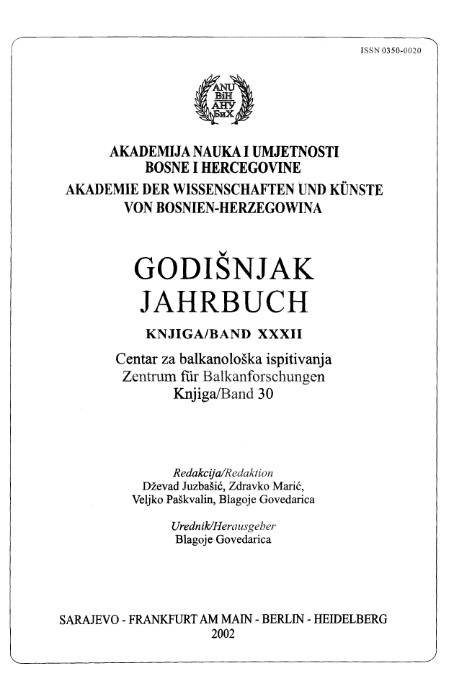Reljefna ploča iz Carevog polja kod Jajca
The Carved Slab from the Carevo Polje near Jajce
Author(s): Nada MiletićSubject(s): Archaeology, Cultural history, Visual Arts, Local History / Microhistory, Ancient World
Published by: Akademija Nauka i Umjetnosti Bosne i Hercegovine
Keywords: Carved slab; Carevo polje; Jajce; National Museum of Sarajevo; wriggling snakes; palmette leaves; tree of life; art work;
Summary/Abstract: This article is an attempt to analyze and determine a carved slab found in 1960 in Carevo Polje, north of Jajce, on the site of Metaljka. The slab, which lay in the earth, is very well preserved and is now in Zemaljski muzej in Sarajevo. The front and upper side of the slab were; treated with sorin' indented tools, while the lateral and the back sides were only roughly carved. The decorative space of the front side shows a composition with ramified pahnette in the middle, flanked with affronted ibises with wriggling snakes in their beaks. The palmette leaves sprout out of leaflike wreath, in fact the Lesbian kymation, while the fish float between their tops. At first sight the scene reminds of the theme of the Tree of Life (Sacred Tree), the leading motif in all ancient oriental religions, later adopted in Christendom, too. This motif, used in all branches of artistic creation and dispersed in the wide spaces and over a very long chronological span, appears in innumerable variants, with animals of most various kinds and types in these hieratic scenes, but I have never come cross the combination with ibises. The palm - palmette, the primordial tree of this motif, full of symbolic meaning, the decorative detail of numberless art works in all times, here is shown almost as an architectural element. Ibis, the sacred bird of the old Egyptian mythology, in the pantheon of which it represents That, the god of death, the moon and heart, the connoisseur of speech, of counting of time and of many other kinds of knowledge, was especially glorified as the exterminator of snakes, particularly at the time of the Nile floods. Ibis appears very often as a hieroglyph or in the papyrus vignettes as a participant in funeral rites, and later on in mosaics, Roman (Pompei), or the early Byzantine (Ravenna, Torcello and others), in manuscript decorations and, most likely, in ivories, known especially from Alexandrinian ateliers, alone or in the so-called Nilotic scenes, which is, it seems to me, represented in the composition of the Carevo Polje slab.
Journal: Godišnjak Centra za balkanološka ispitivanja
- Issue Year: 2002
- Issue No: 32
- Page Range: 493-507
- Page Count: 15
- Language: Bosnian

